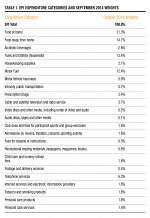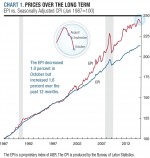Energy Prices Continue to Pull Down EPI
The EPI does not include housing and cars because their prices are fixed by long-term contracts. The EPI measures prices that change from day-to-day.
Despite the October decrease in the EPI, over the past 12 months the EPI increased 1.6 percent while the Consumer Price Index (CPI) increased 1.7 percent. Both the EPI and CPI indicate that price increases are firming just below 2 percent.
In October, energy prices decreased for the third consecutive month providing continued relief to households. Overall, gasoline prices fell 6.2 percent, regular decreased 6.4 percent, mid-grade decreased 6.2 percent, and premium decreased 5.6 percent. Utility bills were restrained by a 3.9 percent decrease in the price of electricity and a 2.3 percent decrease in the price of natural gas.
Wireless phone service, another essential, decreased 1.9 percent in October. Competition in wireless service is heating up. As a result prices are down 5 of the last 6 months. There are now 16 small wireless providers to choose from. Consumers are no longer stuck with Verizon or AT&T.
Food prices increased at a slower rate in October. Prices at the grocery store and at restaurants both increased 0.2 percent. Fresh fruits and vegetables increased 1.4 percent, bread increased 0.8 percent, and breakfast cereal increased 1.5 percent. Cheese increased 1.2 percent and butter increased 4.5 percent due to strong international demand and low inventories.
Meat, poultry, and fish held food priced down in October. Uncooked beef roasts and steaks decreased 0.2 and 0.4 respectively. Pork decreased 0.8 percent, led by a 3.1 percent decrease in bacon. Chicken decreased 0.7 percent and fresh seafood decreased 1.9 percent.
Over the past 12 months food prices have increased 3.1 percent but many staples have increased much faster. Ground beef has increased 18.3 percent and pork has increased 9.8 percent in response to disease and drought. Citrus fruits have increased 9.6 percent because crops continue to be damaged by the greening disease.
Offsetting higher food prices, gasoline prices have decreased 5.0 percent over the past year.
About the EPI
AIER’s Everyday Price Index (EPI) measures the changing prices of frequently purchased items like food and utilities. We do this by selecting the prices of goods and services from the thousands collected monthly by the Bureau of Labor Statistics in computing its Consumer Price Index. The EPI basket contains only prices of goods and services that Americans typically buy at least once a month, excluding contractually fixed purchases such as mortgages. Our staff economists weight each EPI category in proportion to its share of Americans’ average monthly expenditures. In order to better reflect the out-of-pocket prices that consumers experience on a daily basis, the EPI does not seasonally adjust prices.
To learn more about our methodology, view the weights assigned to each component, and browse past EPI updates, visit AIER’s EPI Methodology page.






